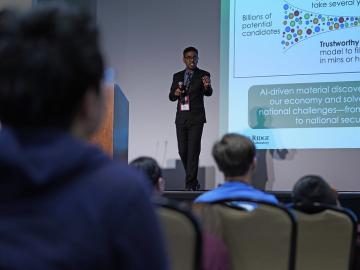
Filter News
Area of Research
- Biological Systems (1)
- Biology and Environment (37)
- Clean Energy (35)
- Computational Biology (1)
- Fusion and Fission (4)
- Isotopes (2)
- Materials (23)
- Materials for Computing (7)
- National Security (11)
- Neutron Science (12)
- Nuclear Science and Technology (1)
- Quantum information Science (4)
- Supercomputing (48)
News Type
News Topics
- (-) Artificial Intelligence (48)
- (-) Bioenergy (51)
- (-) Energy Storage (29)
- (-) Exascale Computing (26)
- (-) Microscopy (20)
- (-) Nanotechnology (16)
- (-) Polymers (8)
- (-) Quantum Science (30)
- (-) Security (11)
- (-) Space Exploration (12)
- 3-D Printing/Advanced Manufacturing (41)
- Advanced Reactors (8)
- Big Data (26)
- Biology (60)
- Biomedical (29)
- Biotechnology (11)
- Buildings (19)
- Chemical Sciences (25)
- Clean Water (14)
- Climate Change (50)
- Composites (8)
- Computer Science (86)
- Coronavirus (17)
- Critical Materials (3)
- Cybersecurity (14)
- Decarbonization (46)
- Education (1)
- Emergency (2)
- Environment (104)
- Fossil Energy (4)
- Frontier (24)
- Fusion (31)
- Grid (25)
- High-Performance Computing (44)
- Hydropower (5)
- Isotopes (27)
- ITER (2)
- Machine Learning (22)
- Materials (43)
- Materials Science (45)
- Mathematics (7)
- Mercury (7)
- Microelectronics (2)
- Molten Salt (1)
- National Security (39)
- Net Zero (8)
- Neutron Science (47)
- Nuclear Energy (55)
- Partnerships (18)
- Physics (29)
- Quantum Computing (21)
- Renewable Energy (1)
- Simulation (32)
- Software (1)
- Statistics (1)
- Summit (30)
- Sustainable Energy (47)
- Transformational Challenge Reactor (3)
- Transportation (27)
Media Contacts

Two ORNL teams recently completed Cohort 18 of Energy I-Corps, an immersive two-month training program where the scientists define their technology’s value propositions, conduct stakeholder discovery interviews and develop viable market pathways.

Researchers at the Department of Energy’s Oak Ridge National Laboratory and partner institutions have launched a project to develop an innovative suite of tools that will employ machine learning algorithms for more effective cybersecurity analysis of the U.S. power grid.

Researchers conduct largest, most accurate molecular dynamics simulations to date of two million correlated electrons using Frontier, the world’s fastest supercomputer. The simulation, which exceed an exaflop using full double precision, is 1,000 times greater in size and speed than any quantum chemistry simulation of it's kind.

ORNL's Guang Yang and Andrew Westover have been selected to join the first cohort of DOE’s Advanced Research Projects Agency-Energy Inspiring Generations of New Innovators to Impact Technologies in Energy 2024 program. The program supports early career scientists and engineers in their work to convert disruptive ideas into impactful energy technologies.

Researchers used quantum simulations to obtain new insights into the nature of neutrinos — the mysterious subatomic particles that abound throughout the universe — and their role in the deaths of massive stars.
Close on the heels of its fourth summer school, the Quantum Science Center, or QSC, hosted its second in-person all-hands meeting in early May. More than 150 scientists, engineers and support staff traveled from 17 institutions to review the QSC’s progress, examine existing priorities and brainstorm new short- and long-term research endeavors.

Researchers at ORNL and the University of Maine have designed and 3D-printed a single-piece, recyclable natural-material floor panel tested to be strong enough to replace construction materials like steel.

Prasanna Balaprakash, a national leader in artificial intelligence, or AI, spoke to some of the highest achieving students in the country at the National Science Bowl in Washington D.C.

When Oak Ridge National Laboratory's science mission takes staff off-campus, the lab’s safety principles follow. That’s true even in the high mountain passes of Washington and Oregon, where ORNL scientists are tracking a tree species — and where wildfires have become more frequent and widespread.

Purdue University hosted more than 100 attendees at the fourth annual Quantum Science Center summer school. Students and early-career members of the QSC —headquartered at ORNL — participated in lectures, hands-on workshops, poster sessions and panel discussions alongside colleagues from other DOE National Quantum Information Science Research Centers.


